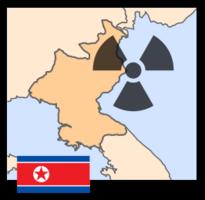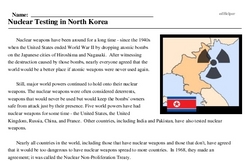Nuclear Testing in North Korea
Nuclear weapons have been around for a long time - since the 1940s when the United States ended World War II by dropping atomic bombs on the Japanese cities of Hiroshima and Nagasaki. After witnessing the destruction caused by those bombs, nearly everyone agreed that the world would be a better place if atomic weapons were never used again.
Still, major world powers continued to hold onto their nuclear weapons. The nuclear weapons were often considered deterrents, weapons that would never be used but would keep the bombs' owners safe from attack just by their presence. Five world powers have had nuclear weapons for some time - the United States, the United Kingdom, Russia, China, and France. Other countries, including India and Pakistan, have also tested nuclear weapons.
Nearly all countries in the world, including those that have nuclear weapons and those that don't, have agreed that it would be too dangerous to have nuclear weapons spread to more countries. In 1968, they made an agreement; it was called the Nuclear Non-Proliferation Treaty.
The treaty set out three international rules about nuclear weapons. The first rule was that nuclear weapons should not continue to spread. The second rule was that countries should work toward one day getting rid of nuclear weapons altogether. The third rule was that all countries should have the right to use nuclear power peacefully to produce energy.
One hundred eighty-nine countries agreed to the treaty. India, Pakistan, and Israel did not. North Korea agreed at first, but later it withdrew from the treaty.
In October 2006, news from North Korea explained why North Korea had withdrawn from the treaty. North Korea had become interested in developing a nuclear weapons program of its own.
The news on October 9, 2006, said that North Korea announced that it had conducted an underground nuclear explosion, a test of a nuclear weapon. The test occurred near the coast of North Korea at 10:35 in the morning. It set off a tremor similar to a 4.2 magnitude earthquake. Radiation was detected that showed that the blast had been a nuclear one.
It was a small nuclear blast compared to earlier nuclear tests by other countries. The output was believed to be about one kiloton. A kiloton is a measure of the energy output of a nuclear explosion. Tests in earlier years by the U.S. had been at about the twenty kiloton level. The tests in India and Pakistan had been close to that level also.
Since the force of North Korea's explosion was small by nuclear explosion standards, it raised some questions. Had North Korea really conducted a full nuclear test? Had the test been successful, or had it failed?




